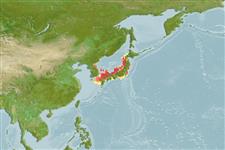Common names from other countries
Environment: milieu / climate zone / depth range / distribution range
Ecologie
Standvastig (Ref. 75927); diepteverspreiding 1 - 200 m (Ref. 275), usually ? - 150 m (Ref. 75927). Temperate; 44°N - 30°N, 128°E - 145°E (Ref. 275)
Northwest Pacific: Japan, Korea and China.
Length at first maturity / Size / Gewicht / Leeftijd
Maturity: Lm ?, range 50 - ? cm Max length : 70.0 cm TL mannelijk/geslacht niet bekend; (Ref. 275)
Combination depth range: min from estimate, max from literature.
Members of the class Cephalopoda are gonochoric. Male and female adults usually die shortly after spawning and brooding, respectively. Mating behavior: Males perform various displays to attract potential females for copulation. During copulation, male grasp the female and inserts the hectocotylus into the female's mantle cavity where fertilization usually occurs. Life cycle: Embryos hatch into planktonic stage and live for some time before they grow larger and take up a benthic existence as adults.
Roper, C.F.E., M.J. Sweeney and C.E. Nauen. 1984. (Ref. 275)
Status op de Rode Lijst van het IUCN (Ref. 130435)
Status bij CITES (Ref. 108899)
Not Evaluated
Not Evaluated
Gevaarlijk voor mensen
Harmless
Gebruik door de mens
Visserij: commercieel
| FishSource |
Tools
Meer informatie
Leeftijd/GrootteGroeiLengte-gewicht parametersLengte-lengte parametersMorfologieLarvenAbundantie
Internet-bronnen
Estimates based on models
Kwetsbaarheid
Moderate to high vulnerability (48 of 100).
